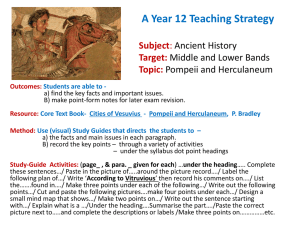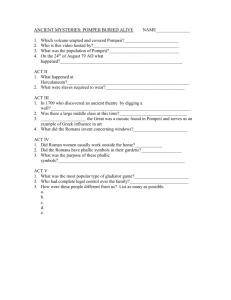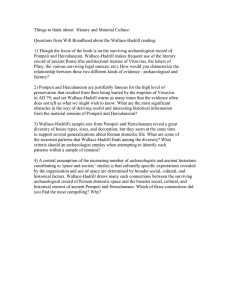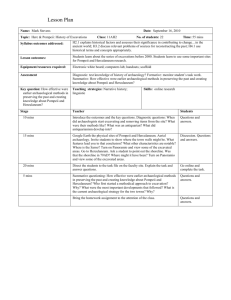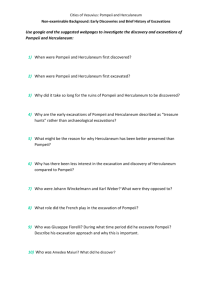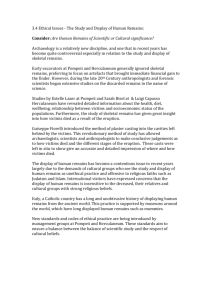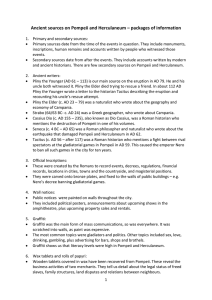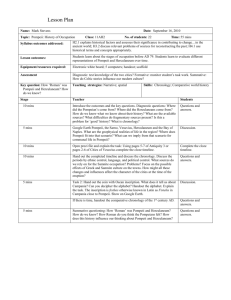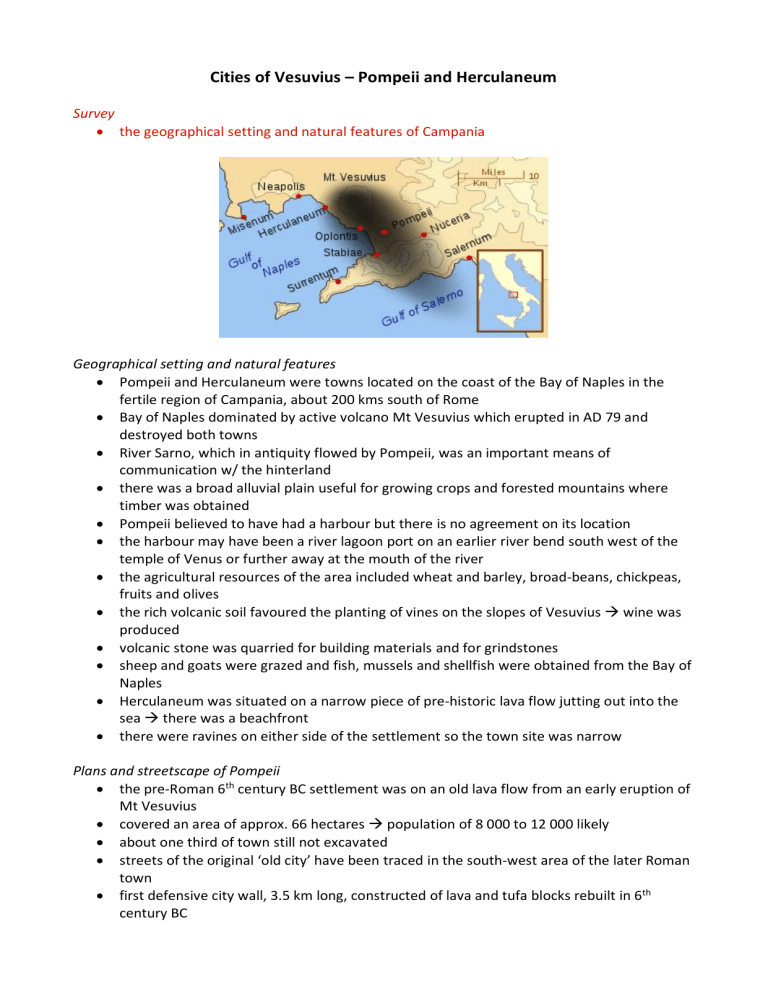
Cities of Vesuvius – Pompeii and Herculaneum Survey the geographical setting and natural features of Campania Geographical setting and natural features Pompeii and Herculaneum were towns located on the coast of the Bay of Naples in the fertile region of Campania, about 200 kms south of Rome Bay of Naples dominated by active volcano Mt Vesuvius which erupted in AD 79 and destroyed both towns River Sarno, which in antiquity flowed by Pompeii, was an important means of communication w/ the hinterland there was a broad alluvial plain useful for growing crops and forested mountains where timber was obtained Pompeii believed to have had a harbour but there is no agreement on its location the harbour may have been a river lagoon port on an earlier river bend south west of the temple of Venus or further away at the mouth of the river the agricultural resources of the area included wheat and barley, broad-beans, chickpeas, fruits and olives the rich volcanic soil favoured the planting of vines on the slopes of Vesuvius wine was produced volcanic stone was quarried for building materials and for grindstones sheep and goats were grazed and fish, mussels and shellfish were obtained from the Bay of Naples Herculaneum was situated on a narrow piece of pre-historic lava flow jutting out into the sea there was a beachfront there were ravines on either side of the settlement so the town site was narrow Plans and streetscape of Pompeii the pre-Roman 6th century BC settlement was on an old lava flow from an early eruption of Mt Vesuvius covered an area of approx. 66 hectares population of 8 000 to 12 000 likely about one third of town still not excavated streets of the original ‘old city’ have been traced in the south-west area of the later Roman town first defensive city wall, 3.5 km long, constructed of lava and tufa blocks rebuilt in 6th century BC walls rebuilt number of times but by 1st century AD were no longer required part of wall facing sea built upon entry to town through 8 gates which connected to the roads leading to other towns Romans standardised original town plan dividing it into more regular grid of city blocks or ‘islands’ (insulae) main streets ran east-west and cut by cross-streets (cardines) running north-south Archaeologists have named main east-west street the Via dell’Abbondanza the Street of Abundance after the figure of ‘Abundance’ found on a fountain an insula, city block, might include mix of houses, big or small, shops, bakeries and artisans’ workshops some larger houses took up most of block some blocks in the town planted as orchards, vineyards or gardens town centred on open space of forum and Temple of Jupiter, the Capitolium, designed to recall the Capitol Hill at Rome Plan and streetscape of Herculaneum built on a promontory formed by a pre-historic lava flow that jutted out into the Bay of Naples town bounded by ravines on eastern and western sides small town had ‘modest walls’ for defence estimated to have been 12 hectares in size and smaller than Pompeii population of between 2 000 and 3 000 people likely only about 5 hectares of town have been excavated to date because of topography town is long and narrow main street decumanus maximus runs east-west and only area to south of the decumanus has been excavated northern part remains buried under modern town of Ercolano forum, located on western side of town and accessed from the decumanus maximus still remains unexcavated 5 cross-streets (cardines) run north-south southern end of Cardo V terminates in ramp down to terrace above ancient beach ancient beach and boat chambers accessed by flight of steps that led down from terrace on east side of town palaestra, a development of early 1st century AD, included shops, a bakery and multi-storey dwellings the eruption of AD 79 and its impact on Pompeii and Herculaneum Pompeii in 18hrs, city ruined and 5000 killed casts of victims preserved in ash some didn’t believe Mt Vesuvius was a volcano – had been quiet for 1500+ years Mt Vesuvius surrounded by fertile soils no Latin word for ‘volcano’ 24th August (or October) 79 AD signs minor trembles no one read signs magma leaking, pressure mounting, earth tremors more frequent 1pm – eruption molten rock turns from lava to foam trapped in superheated pressure-cauldron for 1500 years ejected at supersonic speed which forms churning column that rises into sky minutes after – columns of gas rises 15km into sky, visible in Misenum wind drives column into cloud over Pompeii day turns to night atmosphere – boiling rock mixes with air cools, solidifies, begins to fall takes 30 mins to reach Pompeii – (1hr after eruption) magma turns to pumice stones mixed w/ pumice, cold & dense rocks from volcano (200km/hr) strike w/ deadly force 1000s try to flee big mid-afternoon, volcano thrown over 100 million tonnes of pumice & ash on Pompeii as it collects, weight of pumice threatens to collapse roofs of houses Herculaneum – closer to Vesuvius, people unharmed because of wind 7hrs into eruption – mostly deserted, some trapped due to pumice Pumice and ash suck moisture from air heavier w/ denser rock, part of column collapses, cascading in wave down Vesuvius superheated ash and molten rock churn down mountainside pyroclastic surge headed towards Herculaneum heat so intense, instant death people on beach don’t just burn but turn to charcoal in boat houses, death from thermal shock boiling surge cloud settled on bodies, soft tissues vaporize, teeth and bone shatter, brains boil & explode (300 men, women and children have been found) after eruption, Herculaneum under 25m of volcanic debris Pompeii – still falling pumice massive earthquake – at heart of volcano magma chamber collapses triggers another pyroclastic surge which heads for Pompeii surge cloud runs out of energy just short of Northern wall cloud of toxic gas continues on carbon dioxide & hydrogen chloride (acid burns eyes and throat) from side of column, blistering wave of ash & rock explodes ruins everything in path – hottest and most devastating 100km/hr pyroclastic surge headed for Pompeii death for those in Pompeii not instant first breath inhales hot gas & ash causing lungs to fill w/ fluid – second breath mixes ash w/ fluid creating wet cement in lungs & windpipes – third breath thickens cement causing gasps and suffocation Stabiae – after 18hrs of eruption bottom section of column collapses (Pliny the Elder dies) final & greatest surge travels across Bay of Naples in black cloud final surge kills 1000s who fled into countryside Aftermath Pliny the Younger’s account not believed known as Plinian eruptions in 18hrs 10 billion tonnes of pumice, rock and ash spewed by Vesuvius rescue attempted by Rome city buried and forgot Pliny the Elder viewed eruption and went to Stabiae for better look where he was killed Pliny the Younger wrote report on Vesuvius and eruption – witnessed it from Misenum early discoveries and the changing nature of excavations in the 19th and 20th centuries Giuseppe Fiorelli, director 1860-1875 most significant contribution was the mapping of Pompeii into regions, insulae and numbered doorways his scaled map and 1:100 model of the town (1879) are accurate numbering system allowed any building to be precisely identified and used by Fiorelli at Herculaneum now standard on Roman sites excavated buildings from top down, room by room, shoring up the walls at Herculaneum worked along Cardo III and discovered Central Baths in 1874 developed open-cut excavation at Herculaneum kept detailed records of his excavations and published bulletins of recent work and new finds his plaster casts of the human remains found in the ashes (1863 onwards) became famous showed no scientific interest in the study of the bones until 2015 plaster casts had long hindered scientists from properly studying any skeletal material that mat have been preserved inside Vittorio Spinazzola, director 1911-1924 worked on the Via dell’Abbondanza at Pompeii concentrated not on the excavation of complete buildings built on the reconstruction of the streetscape replaced fallen second storeys and attempted to reproduce the street facades of buildings partial excavation of buildings at Pompeii and use of reinforced concrete resulted in considerable conservation problems today Amedeo Maiuri, director 1924-1961 excavated major part of Herculaneum from under 20m of volcanic sludge influenced by Spinazzola, reconstructed fallen second storeys of buildings and largely rebuilt excavated Roman structures of Herculaneum attempted to recreate an open-air museum of Roman life with objects and furnishings on display in the houses at Pompeii continued excavation of Via dell’Abbondanza finished excavation and restoration of the Villa of the Mysteries and a no. of significant houses in 1950s directed the large-scale excavations in Regions I and II but is criticized for unearthing area too hastily representations of Pompeii and Herculaneum over time Investigating and interpreting the sources for Pompeii and Herculaneum the evidence provided by the range of sources, including site layout, streetscapes, public and private buildings, ancient writers, official inscriptions, graffiti, wall paintings, statues, mosaics, human, animal and plant remains from Pompeii and Herculaneum, as relevant for: - the economy: role of the forum, trade, commerce, industries, occupations Industries and occupations trades known about are crafts which needed large-scale equipment included milling, baking, fulling, dying and tanning around 200 workshops of different kinds identified all over artisans include painters and mosaicists architects, bakers, auctioneers, bankers, carpenters, barbers, dyers, builders, doormen, farmers, goldsmiths, engravers, fullers, porters, scribes, painters, prostitutes, wine-sellers, tanners, weavers, wagon drivers, shoemakers, surgeons, sign-makers and stall-holders Trade both situated in broad alluvial plain helpful for crops sown forested mountains provided good source for timber agriculture in area; wheat and barley, chickpeas, broad-beans, fruits and olives, vegetables and orchards soil which surrounded volcano rich in minerals could support vines for wine volcanic stone quarried for grindstones and building materials animals farmed were sheep and goats fish, shellfish and mussels obtained from Bay of Naples sheep used for meat and wool pigs bred for meat and skin Pompeii imported more goods than exported famous and well-situated sea port, traders from all over Mediterranean came w/ wine, pottery, olive oil and other foods and went home w/ metalwork, wine, olive oil and garum from Pompeii because Herculaneum more resort area for rich and wealthy not main port of trade and economy Commerce archaeological evidence of business records from within Pompeii and Herculaneum show wealthy individuals within towns owned farms situated outside city walls evidence of commercial activities such as banking and giving loans and mortgages recorded on wax wooden tablets currency of Pompeii and Herculaneum was denarii multiple coins found in Pompeii - the social structure: men, women, freedmen, slaves Society divided into 3 main categories of social class top the nobles and rich able to live lavishly and easily middle were citizens and common folk who were free and able to either work for money or be pampered by nobles bottom were slaves and servants Patricians were nobles did not mean were rich but meant they could eventually rise up ranks to emperor meant bloodline came from founding fathers of city of Rome Equitaes were tax-collectors and businessmen Plebeians were lower class could be wealthy most Romans could read and wrote did not include slaves as were not citizens of Rome Heirarchy senatorial elite visited and owned areas of Pompeii and Herculaneum local town elite composed of wealthy landowners and traders involved in politics and running of towns freeborn males could vote and enjoy patronage of those higher up women could own land, run business’ and become respected priestess’ (Eumachia) freedmen remained bound to masters after being manumitted from slavery and could eventually become citizens slaves property of master and had to obey him public slaves owned by State and could work on major public projects - local political life: decuriones, magistrates, Comitium Politics both had form of government following standard rules set out in law of Julius Caesar, the Lex Iulia Municipalis (45 BC) Pompeii Roman colonia where veteran soldiers had been settled Herculaneum not Roman colony but was a municipium 2 chief officials/magistrates called duumviri elected annually by citizens who met in voting assembly (comitia) two lower officials/magistrates called aediles elected annually by citizens in comitia town council/curia not elected body members chosen by duumviri who revised council roll each 5th year graffiti found writing about politicians looking for offices e.g. Balbus and Rufus political patronage by influential men from wealthy families who exercised influence over poorer citizens and groups of craftsmen, dominated political life patrons offered dependent clients assistance and would build up support to win elections all paid homage to the Emperor in Rome with taxes imperium ‘top power’ only emperor had Pompeii Municipia – a self-governing town w/ own annually elected officials would be ‘dictator’ at top in Rome in emergency for 6 months at a time below would be 2 duumviri (Roman consuls), praefectus in emergencies, 10 decuriones (senior officials), curia (after being elected in office, one became a senator) and aediles (who were executives look after games and kept street clean) Pompeii and Herculaneum politics modelled off Rome Duumviri administered justice and were judges in town called together town council and presided over its meetings held highest executive offices in town responsible for public money and public works they supervised expected to use personal funds to provide buildings and benefactions for people every 5 years revised roll of town council, removing and appointing members Aediles supervised marketplace and had responsibility for day-to-day town administration, upkeep of temples and paving of streets common to pay for gladiatorial contests and entertainments public benefactions help them gain higher office Comitium comitia meeting of people held once a year to elect officials for coming year voted for in Voting Halls or Comitium near Forum did not meet during year merely elected officials for the year all debates and decisions took place in council/curia - everyday life: housing, leisure activites, food and dining, clothing, health, baths, water supply, sanitation Leisure activities not required that freedmen work so days consisted of going to bars, gambling, drinking and attending Roman Games at amphitheatre two theatres one larger for spectacles and pantomime and smaller suited to music and recitations those who worked would have worked for 6 hours between dawn and noon, leaving afternoon for leisure gladiator fights popular known through multiple inscriptions carved by women throughout city of gladiator’s names fresco 2 men sitting at wooden table playing game of dice in Roman Empire gambling w/ dice illegal except during Saturnalia festival in Roman literature gambling frowned upon and immoral activity associated w/ drinking and violent arguments Baths popular past-time for rich function not just bathing – place where rich could gather together and talk Roman custom to visit baths daily for cleanliness, business and to meet friends 3 thermal baths located in Pompeii; Central, Stabian and Forum baths each extended to account for growing populations Caldarium was steam room and hot place heated from underneath and then water thrown onto floor – the under-floor heating and air ducts built into walls would have made entire room full of steam when in use cold water piped into separate room enabling bathers to cool off when they wanted Dining Dionysius / Bacchus seen in fresco w/ Vesuvius and grapes Pompeiians had high regard for wine had to be watered down another fresco depicts sale of bread loaves of bread stacked on shop counter and vendor handing them to customers poor used to be able to get free bread historians think inhabitants of Pompeii bought daily bread from bakeries instead of making it themselves fresco showing banquet highlights importance of food as part of daily Roman life taverns popular over 100 taverns in Pompeii thermopolia; bars which sold food and drink had terracotta containers (dolia) sunk into masonry counter where hot food held for customers some bars have decorated back rooms historians theorise these places fast food restaurants restaurant’s menu included cereal, soups, fish, eggs, cheese, garum and sauillum (cheesecake w/ poppy seed glaze) owners and servants used bronze pots and pans original artefacts found in The House of Vetti and found in kitchen large selection of glass vessels discovered at Pompeii bowl and saucepan like vessels would have been used as part of dinner service bottles and small jars would have once held perfume, some utensils and might used scoop water from larger jars silverware found at dig at Moregine, outside Pompeii included plates, goblets, a tray, spoons and drinking cups Food main dip in Pompeii was garum – sauce made by fermenting fish entrails Pompeii’s considered best in empire main source of trade water could not be drunk straight (caused Typhus) put wine in it cuisine sweet and sour blend of sharp tastes with sweet tastes, like honey and figs eating habits differ between social classes slaves had high energy diet of bread, dried fruits, low-quality cheese and wine upper and middle classes had same food wealthy larger quantities and finer ingredients within fast-food restaurant evidence of Mediterranean diet; seafood, legumes, fruits, vegetables and some meat at back of shop where food contained w/ wine and oil utensils used for cooking typical desert consisted of vinegar and brine w/ onions 1st century AD Latin writer on agriculture, Columella, has recipe on how to preserve onions placed in solution made of 2 parts vinegar and 1-part strong brine and left for 2 weeks eggs found intact within ruins of Pompeii Clothing related to Roman fashion on formal occasions upper class would wear togas – depicted in statues and paintings regular days males would wear tunic while females wore stola, maybe with palla, or mantle woman’s undergarment called a peblos Water supply throughout city were water fountains on side of streets where common people would get water population’s water supply fed by aqueduct to public fountain only houses of wealthiest citizens had indoor plumbing others in neighbourhood had to carry water home from trough lead pipes used for running water – Romans advanced due to ability to create easily accessible water system Health lead pipes poisoning theorised to be downfall of Roman Empire make people go mad rich would have been most likely to get lead poisoning as had taps while poor had fountains chemical analysis of skeletons in Pompeii show population generally healthy and wellnourished although some have signs of suffering from lead poisoning poisonous water would have caused much typhus and cholera within Pompeii and Herculaneum Sanitation streets filled w/ carts pulled by horses manure covered roads because of waste stepping stones built so people could cross streets without dirtying themselves officials tasked w/ keeping streets clean for sanitation Forum and public baths would always have public latrine connected to them some houses connected to pit-like septic tank in Herculaneum long sewer hollow dug out under development on east of city, of which palaestra was above homes connected to massive pit through shafts from toilets Public buildings and roads Pompeii city divided first into regione, then insulae and then houses divided by multiple streets paved w/ large polygonal blocks of lava stone and bordered by curbs and pedestrian walkways on most streets are raised stones at regular intervals that pedestrians used to cross street convenient during flood times stones split up w/ gaps so chariots able access streets streets thin one-way only had chariots and other horse-drawn vehicles common in that time streets bordered by shops and houses unknown whether buildings two storeys as roofs collapsed during eruption streets made from basalt basalt stone result of lava which flowed from Vesuvius used to pave road and sidewalks in Pompeii in centre where mansions built around secluded gardens outer edge where small houses, shops and fast food restaurants sat gates leading out from Pompeii named according to cities led to e.g. Nucerian Gate, Herculaneum Gate, Stabian Gate Forum centre of city had Forum main building key feature of any Roman town all roads led to Forum consisted of Temple of Jupiter, Temple of Apollo, Food Markets, Building of Eumachia, Voting Halls (or Comitium) and Law Courts or Basilica decorated w/ columns and other ornaments and had excellent view of Mt Vesuvius Eumachia building’s main industry maybe dying and processing of wool (a Fullonica) name comes from priestess who paid for building and who had plaque inscribed w/ her name and sons Temples Pompeii had major temples to Minerva, Jupiter, Apollo and Venus while both Pompeii and Herculaneum had temple to Isis Temple of Apollo has italic and Greek architecture and rectangular plan sacrificial altar placed opposite flight of stairs which led to raised podium two statues of Apollo and Diana found within Temple of Jupiter in Forum was main centre of religious life built in honour of Jupiter, Juno and Minerva in 2nd century BC was still being restored from earthquake in 62 AD when Vesuvius erupted Temple of the Lares dedicated to protector gods of house and built by people in Pompeii out of gratitude for having survived earthquake Temple of Vespasian had altar in marble and had been decorated w/ ‘sacrificial scenes’ dedicated to Imperial Cult and faced Forum named after emperor Vespasian of Rome who rules from 69 to 79 AD during Pompeii’s eruption Temple of Isis built using Greek style of architecture and was damaged in earthquake is cella of god raised on pedestal within niche within temple water of Nile preserved Doric Temple in Herculaneum perceived as being temple to Hercules who was believed to have founded settlement overlooks Sarno River and visible to those who passed by at sea Amphitheatre amphitheatre at Pompeii earliest known permanent stone amphitheatre in Roman world contained 2 entrances and thought to hold 20 000 people constructed after 70 BC at edge of town during period of Roman conquest and colonization source of entertainment for Romans who did not have to work would gamble and watch Roman Games (gladiator fights and chariot races) gladiator games played against neighbouring towns women not allowed to sit in front stands of amphitheatre Palaestra gymnasium where gladiator’s trained place where young indoctrinated in Roman ideals built in days of Augustus central area for exercises and had 25m pool in courtyard above amphitheatre is ‘Gladiator House’ Theatre large Theatre only theatre in Pompeii and built in 2nd century BC orchestra set in horseshoe shape w/ tiered seatings built along natural slope could accommodate 5 000 people at a time and included extra upper circle added on to increase amount of seating available two side boxes where guests of honour would sit seating divided into 3 different areas by corridors consisted of stone stage and dressing room behind which traversed entire width of stage Public sites used by all; laundry, fullonica and kitchens within restaurants fullonica where clothes dyed urine used to soften wool and get grease out people would walk in mixture of urine and clothes wool would be retrieved raw, spun and dyed purple popular colour for rich as was perceived as being regal – dye was retrieved from shells Herculaneum main buildings main street where Ring Lady Skeleton found (one of the c. 300 skeletons found since 1982 in Herculaneum) said during eruption of Vesuvius 300 people ran to boathouses to be saved a Forum has not been found in Herculaneum said the Forum located to west of main street and holds same features as most fora multiple shops and buildings located on east side of town including palaestra, bakery and multi-story dwellings Villas, houses, shops houses were within city walls villas were homes outside the Pompeiian city walls and normally for rich poor lived in tenement blocks at edge of town and closer one was to centre of town, wealthier they were slaves sometimes lived in wealthy’s homes although mostly lived in farms were collected from conquests excavations of Pompeii have revealed multiple types of stores; butcher shops, bakeries, restaurants, inns, glass shops, pot shops, banks, mills, goldsmiths, jewelry stores, perfume shops, fabric stores and fullers Examples famous houses and shops; the House of Vetti, House of the Surgeon, Villa of Mysteries (outside Herculaneum Gate), House of Menander (1st century AD), Bakery of Modestus within bakery skeletons of 7 mules and 4 donkeys found – grain crushed in past w/ help of animals oven preserved well old quern stones w/ lime mortar residue found (residue used to repair cracks in walls) The House of the Surgeon example of what most houses in Pompeii and Herculaneum looked like one entrance and an atrium at entrance was hole in centre of roof w/ trough below to collect water room to right and left used for business and friends further in home would be courtyard surrounded by rooms (kitchen and bedrooms) in classic peristyle sometimes houses had separate kitchen and most houses didn’t have bathrooms multiple surgeon tools found within house for wealthy individual? The House of Vetti 1st century AD named after possible owners signet rings of ‘Vetti brothers’ found men thought to be freedmen who were wine merchants house had ornate garden visible from front door of house main room, atrium, had an open roof which baffled archaeologists unknown why room had no roof found – stone cooking range and bronze cooking vessels within kitchen historians say cooking took place on top of range and that bronze pots placed on iron braziers over small fire fresco within house shows carpenter with hammer and chisel carving notches in piece of wood –rare evidence of a important craft in Pompeii Pompeii house examples the House of the Papyri where multiple scrolls of papyri found in shelves shelves were holes in wall where few different scrolls w/ tags at end naming topic kept scrolls found blackened and melted into each other making them unreadable the Home of Tiberius Veris held complex baths, gardens w/ flowers and elaborate dining rooms few explicit frescoes found within specific room prompted thought on particular use Herculaneum house examples the House of the Hotel in Herculaneum called ‘hotel’ as has many rooms (1st century AD) like the House of the Wattlework most shops had another level above so owners could live on top of store significant houses; the Samnite House, the House of the Bronze Herm (3rd – 2nd century AD) the House of the Mosaic Atrium and the House of the Stags (1st century AD) in countryside were working farms (villae rusticate) - religion: household gods, temples, foreign cults and religions, tombs Temples religion of Romans based off Greek mythology Greek deities of Apollo, Heracles, Minerva, Dionysius, Demeter and Hermes particularly worshipped within Pompeii and Herculaneum the Egyptian goddess Isis worshipped by all within Pompeii and Herculaneum religion part of daily public and private life in Pompeii were temples to Jupiter, Venus, Apollo, Mercury and Hercules rituals to these gods carried out in Forum were temples of Juno, Minerva and Jupiter, the Temple of the Lares and the Temple of Vespasian Household gods lararium shown in The House of Vetti lararia were shrines to gods of household found in different shapes and sizes in Pompeiian homes range from simple wall-paintings to large and elaborate shrines in family side of atrium there were daily, special ceremonies offered to these deities Cults the Cult of Mithras had virgin birth, single god and drinking of blood Mithras was god of light who came from coast of Western Turkey (Tarsus, where St Paul was from) had some popularity in Pompeii and Herculaneum Imperial Cult extremely popular and was worship of the emperor at the time of eruption Vespasian was emperor evidence of fresco depicting worship of Dionysius in Villa of Mysteries in Herculaneum Jews and Christians believed to have lived in Pompeii, given inscriptions to do w/ their religion figurine of Hindu goddess found – said to be Lakshimi, fertility goddess evidence of cult of Sabazius, Thracian fertility god shrine unearthed contained 2 terracotta vases w/ offerings Roman state cult centred on public worship of Jupiter, Juno and Minerva deities worshipped at Rome at Capitolium priesthoods very prestigious and filled by members of town council and magistrates Temple of Jupiter dominated forum at Pompeii Capitolium at Herculaneum remains unexcavated public worship involved animal sacrifice in front of temple and offering of incense Imperial cult from time of Augustus imperial ruler cult, influenced by Greek hero cults and concepts of divine kingship, developed in Roman world at Herculaneum there was an Augusteum w/ huge statues of the emperor and Augustales, priests of the cult of the emperors at Pompeii there was a temple of Fortuna Augusta and one dedicated to the genius (divine spirit) of Augustus Tombs not hidden but constructed near gates and outside city walls of Pompeii and Herculaneum there is a necropolis along near every road going into Pompeii decorated w/ columns, frescoes, statues, pilasters and mosaics some tombs had terracotta panels which depicted scenes from the owner’s life if body cremated ashes placed in urn and then placed in niche within tomb offerings to dead placed on flat stones and a trincilium was where banquets in dead person’s honour held - the influence of Greek and Egyptian cultures: art and architecture Greek influence both towns in early stages had distinctly Greek character due to deliberate use of Greek architectural elements early Pompeii and Herculaneum under strong cultural influence of Cumae and Neapolis, Greek settlements in Bay of Naples, and Poseidonia, on south coast, outside bay influenced by Hellenistic cities of East copied elements of Greek architecture and civic design late 2nd century BC Samnite House at Herculaneum example of Hellenistic in style Greek architectural orders – Doric, Ionic and Corinthian – employed form early time at Pompeii and Herculaneum sports field (palaestra), market place (agora) and theatre key Greek civic spaces early Triangular Forum at Pompeii w/ impressive entrance way (propylaeum) of 6 ionic columns and colonnade of 95 Doric columns also reveal early Greek influence Greek deities such as Apollo and Venus worshipped long before Roman state gods introduced Herculaneum named after Greek god Herakles Dionysius, Greek god of wine, fertility and spiritual intoxication was worshipped Greek-style field athletics practiced Egyptian influence cult of Isis well established at Pompeii temple of Isis first built before Romans gained control of Pompeii temple of Isis found in Herculaneum due to inscription on front alongside 15 statues of goddess Isis showing domestic worship in House of the Golden Cupids at Pompeii lararium shrine in peristyle features depictions of Egyptian cult objects and images of Isis, Anubis, Serapis and Harpocrates an alabastar statuette of Horus, son of Isis, found in House of the Golden Cupids at Pompeii statuette of Isis suckling baby Horus recovered from domestic context at Herculaneum glazed terracotta statuette of god Bes, protector on childbirth, recovered from the House of Loreius Tiburtinus at Pompeii frescoes made using wet plaster and paint in Herculaneum fresco depicts Cult and worship of Isis brought from Egypt goddess grew into major cult within Rome in fresco high priest stands at entrance to temple and looks down on ceremony being supervised by priests w/ shaven heads one priest tends sacred fire and another leads the faithful in worship daily rites conducted in temples and within homes Reconstructing and conserving the past changing interpretations: impact of new research and technologies Ancient paintings from 1970s American archaeologist Wilhelmina Jashemski pioneered new work on reconstruction of ancient gardens, orchards and vineyards at and near Pompeii by taking plaster casts of plant roots Diet the Anglo-American project in Insula VI.1 at Pompeii established through a study of refuse that pigs most popular source of meat, followed by sheep and chickens meat from cattle rare from 1995 to 2004 Andrew Jones of the University of Bradford studied quantities of recovered fish bone from Insula VI.1 at Pompeii and established fish did not play large part in diet of people there in 1990s Mark Robinson, University of Oxford, worked on refuse deposits in Region One at Pompeii found that kitchen and table waste included olive stones, walnut shells, fishbones and shellfish latrine deposits yielded many fig pips, cereal bran, seeds and small fish bones in 2014 and 2015 Mark Robinson and Erica Rowan published findings of investigation of Cardo V sewer line at Herculaneum macro-botanical material found in materialised form established figs, grapes, olives, eggs, fish and shellfish commonly eaten foods Fuelling Pompeii in 2014 Robyn Veal undertook scientific studies of ancient timber and charcoal remains that established mountain origin of woods used for building and fuel New advanced technologies for reading texts in 2007 Lidia Falcone and colleagues used Near Infrared Reflectography to read the text of a damaged painted notice on a water tower at Herculaneum in 2001 scholars working on papyrus texts from the Villa of the Papyri used NASAdeveloped multi-spectral imaging to read the writing in 2015 a team led by Vito Mocella from the University of Naples employed X-ray phasecontrast imaging to virtually ‘unroll’ a curved papyrus scroll and then read the writing within issues of conservation and reconstruction: Italian and international contributions and responsibilities Issues of conservation and reconstruction by 1990s Pompeii and Herculaneum state of crisis due to chronic lack of funding led to lack of basic maintenance over many years problem compounded by inappropriate materials used in earlier 1920s and 1930s restorations and damaged by earthquake and millions of tourists Roman buildings endangered and on point of collapse being overcome by weeds and vines overrun by wild cats and dogs looting hot climate means multiple weeds grow everywhere – money produced from tourist fees and donations goes to killing weeds lack of money being invested in real conservation of site need to record notable houses, contents and features need to set-up online database to record findings of the site directors appointed by Italy to manage site have shifted focus from excavation to conservation since 1960s recently state of emergency w/ Pompeii and Herculaneum declared ministers intend to appoint special commissioner to oversee both sites Antonio Irlando, the regional councillor responsible for artistic heritage, mentioned that, “every year at least 150 sqm of fresco and plasterwork are lost for lack of maintenance.” UNESCO and ICOMOS in 1997 Pompeii and Herculaneum World Heritage listed due to unique prospect of having captured moment in history w/ outstanding accuracy in 2000 ICOMOS filed report for ancient sites stating they suffered from physical and climatic influences (heat and humidity), decay of frescoes, use of unsuitable conservation and restoration materials, inadequate roofing, neglect and vegetation and microbiological infestation also mentioned sites have received little attention and consideration The Herculaneum Conservation Project established 2001 by David Packard collab with British School at Rome and US-based Packard Foundation significant for academic advice and funds, respectively aim to support local heritage authority in conservation of site problems identified include deterioration of frescoes, water damage and animal damage aim to slow decay, test and implement long-term conservation strategies, provide knowledge and documentation of Herculaneum for future reference, gain archaeological knowledge, conserve and improve access to artefacts found and promote greater consideration of Herculaneum by the scientific and general community since 2002 project greatly influenced and helped Herculaneum 2011: 85 leaking roofs replaced, 2000 2/3 of site closed and reopened in 2013 have created accurate and up-to-date database on excavations and photographs, excavated new areas, conserved older areas and reconstructed artefacts Great Pompeii Project in 2010 collapse of House of Gladiators brought allegations of neglect and misuse in 2013 ICOMOS-UNESCO reported issues w/ water damage, need for tourist management and inadequate conservation European Union and Italian government teamed up to spend 105 million euro on conservation and management of Pompeii by end of 2015 created The Great Pompeii Project which looked at conservation, maintenance and restoration issues in Pompeii to fix them brought Pompeii from being listed under ‘World Heritage in Danger’ and have conserved most buildings in Pompeii in dire need project ensured until end of 2019 the Pompeii Sustainable Preservation Project privately funded organisation by large number of research facilities globally who’ve decided to study long-term sustainable conservation and restoration strategies in Pompeii said this project will come into play after 2019 when Great Pompeii Project ends ethical issues: excavation and conservation, study and display of human remains Excavation and conservation archaeological ethics hold that archaeologists should make it a primary goal to identify, protect and conserve archaeological resources methods used for conservation and restoration are governed by international code of ethics known as Venice Charter for the Conservation and Restoration of Monuments and Sites require archaeologists to focus on excavation and conservation of endangered sites rather than sites not under threat conservation considered desirable so future archaeologists have database to work from in 1999 Pietro Giovanni Guzzo, then superintendent at Pompeii, declared a moratorium on all further excavations of both Pompeii and Herculaneum ushered in period of debate among historians and archaeologists on whether to focus on conservation or excavation in Pompeii 44 of the 66 hectares of urban area are visible generally agreed the other 22 hectares must be left unexcavated to preserve them for the future some classicists argued for continuing excavations in hope of finding more texts revealing ancient Roman life the Villa of the Papyri at Herculaneum is at the centre of the debate because it could contain more of the carbonized rolls already discovered scientific breakthroughs made by reading them debate renewed in 2016 when a group of British, American and French scholars called for excavation of the Villa of the Papyri at Herculaneum to be resumed wrote to the Times newspaper insisting that the excavation of the Villa had to be completed World Heritage site’s management plan of 2017 says no plans to excavate further at this time lack of staff already prevents significant proportion of the sites already excavated from being visited any excavation will be limited to the completion of sites already partially uncovered Study and display of human remains researchers required by institutions and museums to abide by professional code of ethics to treat human remains w/ respect and care the display of human remains is still occasionally justified on the grounds of scientific or educational necessity not to be a form of entertainment a code of ethics developed in 2006 by the International Council of Museums the ICOM established a no. of guidelines for the collection, study and display of human remains it mandated that if human remains displayed ‘they must be presented with great tact and respect for the feelings of human dignity of all peoples’ (Ethics 4.3) practice at The British Museum, the Museum of London and the Manchester Museum is to handle and display human remains with the utmost respect signs outside display room alert people who might find the display of human remains to be offensive signs call for ‘respective behaviour’ displays are designed to be science-based and educational a didactic purpose is sometimes used to justify the showing of actual remains other museums prefer to display casts, photographs or replicas rather than the actual human remains in Italy there is no public debate about the ethics of displaying ancient human remains at Pompeii, as recently as 2015, casts of the victims were displayed to tourists in a new exhibition without any concern for the ICOM code of ethics at Herculaneum the actual bones of the victims are not displayed in the boatsheds but casts of the skeletal forms are shown instead Pompeii known for life-like casts of last positions of those who died in eruption of Mt Vesuvius in 79 AD way these casts were made was when bodies covered w/ ash, pumice and other volcanic debris after person’s death inside of bodies rotted away leaving void filled w/ bones when the hollow casts found by Giuseppe Forelli, plaster was used to fill void to recreate last moments of those who died due to Vesuvius researching of the casts has given historians and archaeologists great insight into the ancient world of Pompeii recently 2 specific casts have been put through CT scans for information o 1st cast was the alleged ‘Moor’ 9th cast ever made – had flared lips characteristic of African race iron bar found in hand possibly for escape is naked from waist down possibly meaning were gladiator or slave CT scan revealed was a juvenile male (around 15 years old) and white o 2nd cast was ‘Cast No. 10’ part of large group who died trying to escape through main gate was 15th victim outside putimola supposed male tried to escape with worldly goods CT scan revealed body looked female due to hip bones researching human remains holds multiple possibilities for further enlightenment about Pompeii display of those human remains, while not respectful of those who died, allows general public to experience history, learn something for themselves and appreciate the past problem can be fixed through displaying copies of original casts and transporting those around the globe or displaying them at the ancient site real casts can be re-buried, and the victims of Vesuvius can rest peacefully another way to fix problem is through holographic displays – real people can be simulated to create a real and true experience of what life was like in Pompeii and Herculaneum, and in their last moments value and impact of tourism: problems and solutions Tourism world captivated by sites since discovery boosted enthusiasm for ancient history Pompeii receives 2.5 million tourists per year whilst Herculaneum has over 500 000 cost of entry in Pompeii 20 euros each person large number of tourists and lack of funds creating problem w/ pollution and vandalism trampling of ancient pavements and lead pipes, carving of people’s names on buildings and stealing of fragments greatly impacted Pompeii particularly Pompeii difficult to protect because of size though dogs patrol premises, artefacts still stolen entry payments to Pompeii added in 1998 not enough to protect site in World Heritage Report of 2017 a sustainable tourist system discussed divert tourists from Pompeii to other ruins of Vesuvius, e.g. Herculaneum and Oplontis visitor quotas and themed itineraries also discussed as being practical way to control tourists Herculaneum in 1990 armed robbers stole approximately 250 artefacts from skeletons on beach, which had been stored donations from America sent to Herculaneum to improve gutters, drainage and droppings of pigeons not been able to greatly impact site
